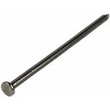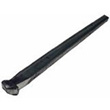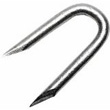Nails might seem like the simplest and least complicated piece of the DIY toolkit, but understanding the difference between a Round Wire Nail and a Panel Pin will help to make your home improvement projects more successful and easier to complete. It is a good idea to have a selection of the most common types of nail in your toolkit, but if you need more specialised nails for a task, you can find a huge range at any of the big DIY stores or online.
This guide will look at many of the different types of nail available, as well as what they are most commonly used for. You can also take a look at our guide to the different Screws and Bolts available.
Types of Nail
 Round Wire Nail
Round Wire Nail
This large headed nail is good for strong fixings in most carpentry jobs.
Oval Wire Nail
Good for general carpentry tasks. Oval shape reduces the chance of splitting the wood.
Round Lost Head
Again, good for general joinery. Perfect if you want to be able to punch the head below the surface of the material.

Cut Clasp
All purpose carpentry nail.
Cut Floor Brad
All purpose nail. Strong and secure if used correctly.
Get over 16000 woodworking plans. Learn how to build anything from furniture to birdhouses out of wood. Clear and detailed plans that guide you through the process of each project step-by-step.
Panel Pin
Ideal for very fine joinery. The thin gauge and small head means it can easily be driven below the surface and out of sight.
Hardboard Pin
Self countersinking nail. As the name suggests, ideal for use with hardboard (and plywood, block board, etc).
Screw Nail
Used to attach sheets of material to timber. Used in wooden floor construction.
Helical Threaded Nail
Specialist nail used for sheet roofing. Threaded to give extra grip.
Plasterboard Nail
For attaching plasterboard to studs. Jagged sides to improve grip.
Clout Nail
Use in fencing and roofing.
Large Head Clout Nail
For fixing roofing felt or other external fabrics.
Pipe Nail
Used for fixing pipes and guttering into masonry and brickwork.
Masonry Nail
As the name suggests, used for tasks when a material needs to be attached directly to masonry. Made of hardened steel.
Cut Tack
Generally used for fixing carpets and flooring.
Sprig
Headless tack for holding glass into wooden frames. Sprigs are then covered with putty.
 Staple
Staple
U-shaped wire staples are used for attaching wire to timber.







